Table of Contents
As a Software Asset Management (SAM) pro, you spend most of your time looking after your top software publishers, like Microsoft or Adobe. They’re often the most expensive and critical applications for your business, so it’s important to manage them with a high level of scrutiny.
But what about all your other software titles? With the ever-increasing use of SaaS, the average large enterprise now has 660 applications and spends $284M annually on SaaS. That’s not counting your on-premises software. Outside of your top 10-20 core suppliers, that leaves hundreds of applications unmanaged—and a good percentage still unknown.
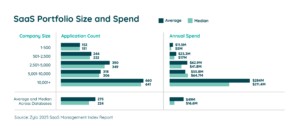
In this blog, we’ll explore why ongoing SaaS discovery of these long-tail applications is critical for your software management program. Discover how SAM pros can make a greater impact on the business by managing them.
What Are Longtail SaaS Applications?
Longtail SaaS applications are smaller, department-level SaaS purchases often made outside of IT’s oversight. They’re typically lower in cost and used by fewer employees—so they’re not a priority for all businesses.
Now, this is a general definition of longtail SaaS apps. In reality, there’s no universal standard as to what is considered long tail. The criteria you use to qualify apps as long tail depends on your organization’s size and complexity, procurement policies, and risk tolerance—among other factors.
We often see companies establish a specific threshold to identify longtail applications. For instance, you could use a spend threshold, where an app under $100,000 is considered long tail. Alternatively, you could consider any app bought by business units long tail. Ultimately, it’s what makes sense for your business.
The Rise of Longtail SaaS Apps
The proliferation of SaaS solutions has led to a veritable explosion of longtail applications. These applications, which cater to specific departments or niche use cases, are quickly becoming integral to organizational workflows.
Zylo’s Zybrary—our comprehensive SaaS database that powers Zylo’s ability to identify and categorize software—has identified more than 24,000 SaaS applications, highlighting the sheer abundance of options available to businesses. With a longtail app available for every conceivable use case, the software usage landscape has become increasingly crowded.
While niche applications may not be a significant concern for SAM professionals due to minimal spend or usage, the advent of SaaS has changed the game. Despite constituting a small portion of an organization’s overall software expenditure, longtail SaaS applications collectively pose notable challenges. These challenges range from hidden security risks and unexpected costs to a lack of control and visibility.
Unlike their on-premises counterparts, longtail SaaS apps operate outside the purview of IT departments, contributing to the growing phenomenon of shadow IT.
Why Ongoing Discovery on Longtail SaaS Apps Matters
Because longtail SaaS apps are often used without IT oversight, they are often brought into the business as shadow IT. While shadow IT apps represent just 4% of spending, they make up a substantial 35% of the software stack.
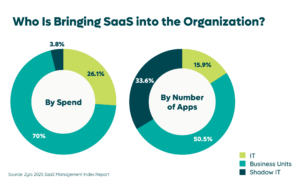
To uncover the longtail apps in your stack—and their associated risks—always-on SaaS discovery is essential. It’s a vital tool for SAM professionals to gain visibility into the entire software landscape on a regular cadence.
Why is this ongoing visibility important? You need data to understand the big picture and inform how you will address the financial, security, and operational risks of these applications.
Let’s explore the importance of ongoing discovery for longtail SaaS apps in greater detail.
Address Compliance Concerns
Without ongoing discovery and evaluation, SAM professionals will struggle to address compliance concerns, which only increase with longtail apps.
Regulatory Compliance
If purchased outside of policy, many longtail SaaS applications may not adhere to industry regulations or data privacy laws. As such, they pose a direct threat to maintaining regulatory compliance efforts.
Without the right visibility into the data practices of these applications, organizations will struggle to enforce data governance frameworks. The use of non-compliant apps can result in hefty fines, reputational harm, and other legal ramifications.
License Compliance
The same train of thought applies to license compliance. If longtail apps aren’t known or managed, how do you know if you’re compliant with licensing? Ongoing discovery ensures that you know what apps you have and their effective license position (ELP) so you can take the right steps to ensure compliance. This is especially important as it pertains to overages or true-ups, which can be common with SaaS in the enterprise if unmonitored.
Increase SaaS Business Value
Proactive management of longtail apps presents a significant optimization opportunity—both financially and operationally. By identifying underused licenses and consolidating redundant functions across longtail applications, you can streamline your software inventory and maximize ROI.
License Optimization
Underused SaaS licenses are not only inefficient but costing you a pretty penny. On average, enterprises use only 45% of their SaaS licenses, resulting in a staggering $127.3M in wasted spend annually. It’s never been more important for enterprises to conduct thorough assessments of their software usage and licensing agreements to identify optimization opportunities.
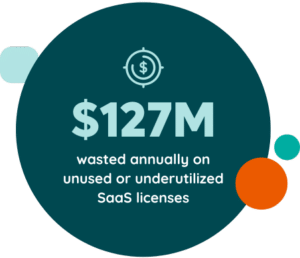 Because SaaS is hosted in the cloud, understanding your effective license position on longtail apps takes just a few clicks—unlike on-premises software. Without visibility into these apps, you can’t even do that. As a result, you’re missing a huge opportunity to ensure you’re making the most of the licenses you’ve purchased and optimize as needed.
Because SaaS is hosted in the cloud, understanding your effective license position on longtail apps takes just a few clicks—unlike on-premises software. Without visibility into these apps, you can’t even do that. As a result, you’re missing a huge opportunity to ensure you’re making the most of the licenses you’ve purchased and optimize as needed.
Consolidating Redundant Apps
Consolidating functionality across redundant longtail apps allows you to simplify your software portfolio and reduce overall spending.
Naturally, consolidation results in more users on fewer software titles. When more users are on a standardized title, it fosters better collaboration. Users are working from the same tool, not to mention data is less scattered across the organization.
If you consider the cost implications, rationalization is a meaningful way to trim back. In our 2025 SaaS Management Index, we analyzed the potential savings hiding in the top three most redundant app functions: online training classes, project management, and team collaboration. Depending on how many apps you can or want to remove, we found an average of $477K to $2.8M in potential cost savings.
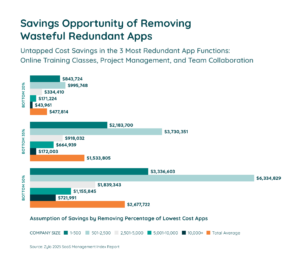
Without discovery of your longtail SaaS applications, it’s difficult to remove redundancy from your stack. That’s because you can’t see the full picture, leading to poor business decisions—and, let’s face it, maybe a little regret.
You need to have a complete list of all the apps for a specific function to do a thorough analysis. If not, there may be apps that stay that should really have been cut—and vice versa.
SAM professionals play a pivotal role as advisor to the business. Their expertise and vigilance in identifying these optimization opportunities provides ongoing value, making them an integral part of your company’s operations.
Stay Ahead of Security Risks
Due to the lack of vetting and oversight, the security posture of these longtail SaaS apps remains largely unknown. Our data shows that 65% of expensed apps carry a “Poor” or “Low” security score, indicating widespread vulnerabilities within this software category. You can’t address what you can’t see, and shadow IT frequently slips past organizational oversight and protocols.
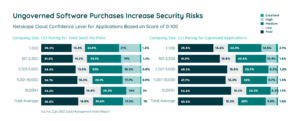
This data indicates potential widespread vulnerabilities for your organization. For example, security vulnerabilities can have consequences ranging from data breaches to PII exposures. As a result, your business could potentially suffer financial losses, reputational damage, and legal liabilities.
You can’t manage what you can’t see. Enterprises must centralize every app before they can proactively address security risks. Implementing robust security measures and regular assessments of longtail applications can only happen after the discovery phase.
Get a Handle on Longtail SaaS Apps
It’s evident that managing longtail SaaS apps presents unique challenges and opportunities for the enterprise. From addressing security risks and compliance concerns to optimizing expenditures and streamlining operations, SAM pros play a key role in helping navigate the complexities of modern software ecosystems.
Managing longtail apps demands ongoing attention and vigilance. That’s because new SaaS apps are constantly entering your software environment—12 per month on average for large enterprises. Left unmanaged, that means your portfolio could grow 22% this year, underscoring the importance of discovering and monitoring your apps regularly.
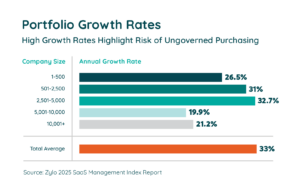
By adopting a proactive approach to ongoing discovery, evaluation, and optimization, organizations can mitigate risks, maximize the value of their software investments, and ensure compliance with regulatory requirements. SAM professionals, armed with the right tools and strategies, are well-positioned to lead these efforts and drive operational excellence and innovation in today’s dynamic SaaS environment.
Learn how Zylo can help support your Software Asset Management practice.

